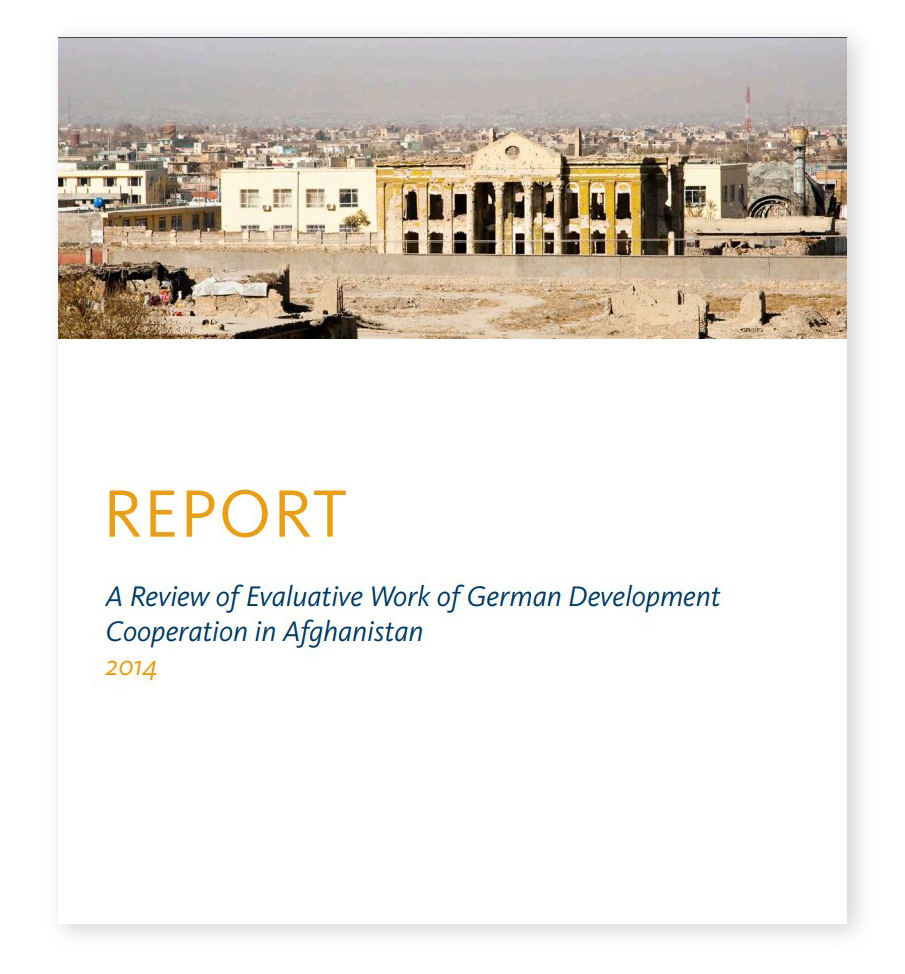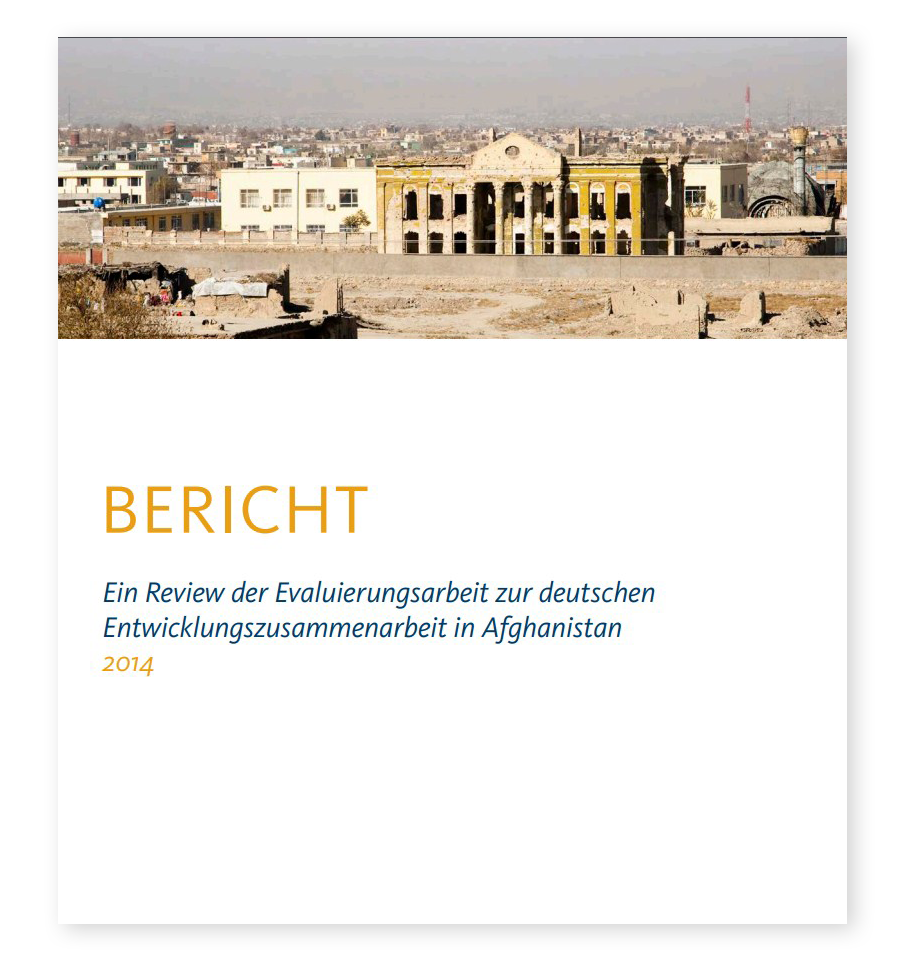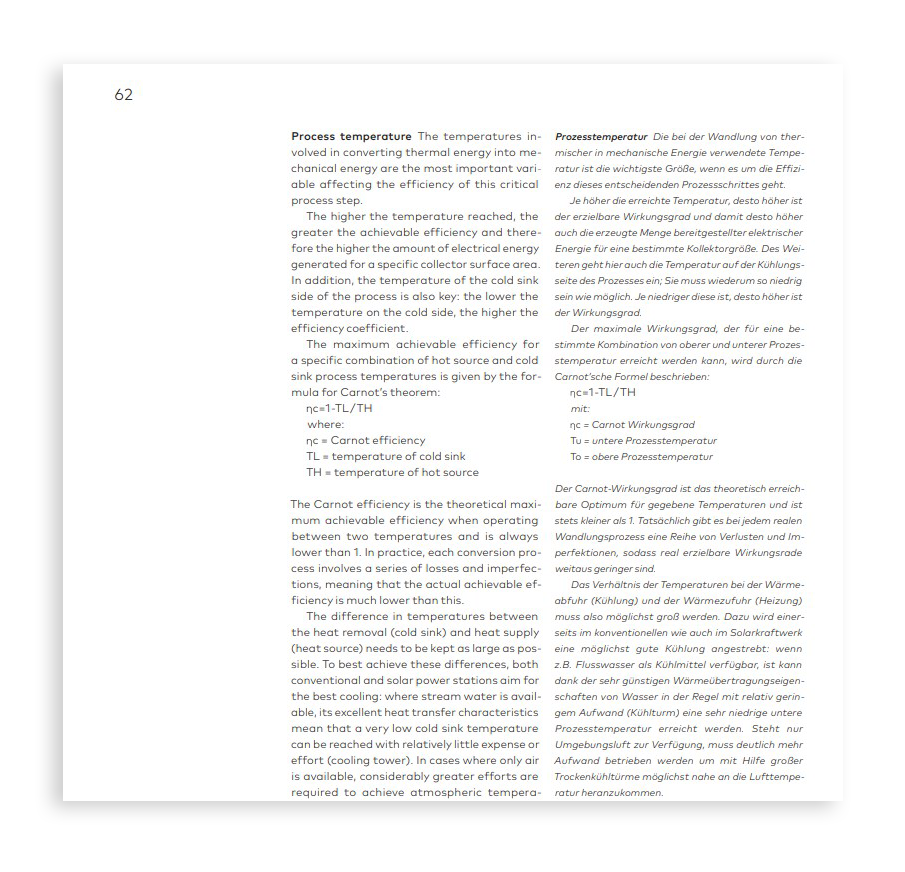Portfolio
For data protection reasons, we can only provide an overview of a small part of our work here. Specifically, we show you material that is already public and accessible on the Internet which can be viewed by everyone.
WORK SAMPLE:
SPECIALIST TRANSLATION. FIELD: DEVELOPMENT COOPERATION / EVALUATION
“Report – A Review of the Evaluation Work on German Institute for Development Evaluation in Afghanistan”, DEval, German Institute for Development Evaluation 2014
Work: Translation of the entire report (around 80 pages) from English into German
Source text: German Development Cooperation Institute (DEval). Dr. Mary Beth Wilson and Renate Kirsch.
1.-Background and Objectives of the Review The Federal Republic of Germany is the third largest bilateral donor of development aid in Afghanistan following the USA and Japan. Up through 2014 federal funds for German development cooperation (GDC) have amounted to over 2 billion euros, of which 1.575 billion euros have been allocated through the Federal Ministry for Economic Cooperation and Development (BMZ). Afghanistan is the main receiving country of bilateral funds allocated through the BMZ. The unique position of this partner country demands continual observation of the effectiveness of the allocations provided, which implicitly suggests reviewing whether and how effectiveness has actually been observed. The Advisory Board of the German Institute for Development Evaluation (DEval) has requested the Institute to provide a review of the types, scope, quality, and usefulness of all evaluations of GDC conducted under the aegis of the BMZ. Using this information, the review should also present recommendations for designing an evaluation program which can support further shaping of the BMZ-country-portfolio in Afghanistan based on robust evidence. Therefore, this study is not an evaluation of GDC interventions in Afghanistan on its own, but is rather characterized as a review of the evaluations which have already been conducted on projects and programs funded by BMZ.
Zieltext: Deutsche Übersetzung Sarah Schneider
1. Hintergrund und Ziele der Untersuchung Die Bundesrepublik Deutschland ist nach den USA und Japan der drittgrößte bilaterale Geber in Afghanistan. Mit Stand Anfang 2014 beliefen sich die deutschen staatlichen Mittel für die Entwicklungszusammenarbeit (EZ) in Afghanistan auf mehr als 2 Mrd. Euro, wobei der Beitrag des Bundesministeriums für wirtschaftliche Zusammenarbeit und Entwicklung (BMZ) 1,575 Mrd. betrug. Afghanistan ist der Hauptempfänger bilateraler Leistungen durch das BMZ. Die herausgehobene Stellung dieses Partnerlandes erfordert eine kontinuierliche Beobachtung der Wirksamkeit der eingesetzten Mittel und legt daher eine Überprüfung nahe, ob und wie diese Wirkungsbeobachtung tatsächlich geschehen ist. Der Beirat des Deutschen Evaluierungsinstituts der Entwicklungszusammenarbeit (DEval) hat das Institut gebeten, eine Bestandaufnahme zu Art, Umfang, Qualität und Nutzung der bisher durchgeführten Evaluierungen der EZ unter der Ägide des BMZ vorzunehmen und hierauf aufbauend Empfehlungen für die Ausgestaltung eines möglichen Evaluierungsprogramms auszusprechen, das eine evidenzbasierte Gestaltung des BMZ-Länderportfolios in Afghanistan unterstützt. Dementsprechend stellt die vorliegende Studie keine eigenständige Evaluierung von EZ-Maßnahmen in Afghanistan dar, sondern hat den Charakter eines Reviews bereits durchgeführter Evaluierungen der vom BMZ finanzierten Vorhaben.
DEval, German Evaluation Institute for Development Cooperation
WORK SAMPLE:
SPECIALIST TRANSLATION . FIELD: TECHNICAL TRANSLATION / TECHNICAL DOCUMENTATION
“Themed booklet Sun / Sun”, new edition 2019, SBP schlaich bergermann and partner
Work: Translation DE <> EN and final editing / proofreading DE <> EN des
Source text DE
Authors: Markus Balz, Thomas Keck, Wolfgang Schiel, Gerhard Weinrebe, Fabian Gross, Willem Landman, Bernd Zwingmann
p. 62
Prozesstemperatur
Die bei der Wandlung von thermischer in mechanische Energie verwendete Temperatur ist die wichtigste Größe, wenn es um die Effizienz dieses entscheidenden Prozessschrittes geht. Je höher die erreichte Temperatur, desto höher ist der erzielbare Wirkungsgrad und damit desto höher auch die erzeugte Menge bereitgestellter elektrischer Energie für eine bestimmte Kollektorgröße. Des Weiteren geht hier auch die Temperatur auf der Kühlungsseite des Prozesses ein; Sie muss wiederum so niedrig sein wie möglich. Je niedriger diese ist, desto höher ist der Wirkungsgrad. Der maximale Wirkungsgrad, der für eine bestimmte Kombination von oberer und unterer Prozesstemperatur erreicht werden kann, wird durch die Carnot’sche Formel beschrieben:
c=1-TL/TH mit:
c = Carnot Wirkungsgrad
Tu = untere Prozesstemperatur
To = obere Prozesstemperatur Der Carnot-Wirkungsgrad ist das theoretisch erreichbare Optimum für gegebene Temperaturen und ist stets kleiner als 1. Tatsächlich gibt es bei jedem realen Wandlungsprozess eine Reihe von Verlusten und Imperfektionen, sodass real erzielbare Wirkungsrade weitaus geringer sind. Das Verhältnis der Temperaturen bei der Wärmeabfuhr (Kühlung) und der Wärmezufuhr (Heizung) muss also möglichst groß werden. Dazu wird einerseits im konventionellen wie auch im Solarkraftwerk eine möglichst gute Kühlung angestrebt: wenn z.B. Flusswasser als Kühlmittel verfügbar, ist kann dank der sehr günstigen Wärmeübertragungseigenschaften von Wasser in der Regel mit relativ geringem Aufwand (Kühlturm) eine sehr niedrige untere Prozesstemperatur erreicht werden. Steht nur Umgebungsluft zur Verfügung, muss deutlich mehr Aufwand betrieben werden um mit Hilfe großer Trockenkühltürme möglichst nahe an die Lufttemperatur heranzukommen. Während die Kühlung im Solarkraftwerk mit bekannten und etablierten Verfahren bewerkstelligt wird, bestehen die Herausforderungen vor allem darin, dem Wandlungsprozess Wärme auf hohem Temperaturniveau zuzuführen, dennoch bereits in diesem ersten Prozessschritt einen hohen Wirkungsgrad zu halten und zugleich die Kosten zu minimieren. Aus den beschriebenen Zusammenhängen wird klar, warum die Bemühungen, die Kosten solar erzeugter elektrischer Energie weiter zu senken auch zum Ziel höherer Prozesstemperaturen geführt haben. So wird das bei Parabolrinnenkraftwerken bis ca. 2015 durchweg verwendete synthetische Öl (max. 400 °C) zunehmend durch Flüssigsalz (max. 550 °C) ersetzt.
Zieltext EN
Translation into English and final proofreading of the English edition: Jason Shilcock. Expert proofreading of the English edition: … (“Industrial Engineer”). Final proofreading of the German edition: Sarah… (German Philology / Romance Studies / examined translator)
p.62
Process temperature
The temperatures involved in converting thermal energy into mechanical energy are the most important variable affecting the efficiency of this critical process step. The higher the temperature reached, the greater the achievable efficiency and therefore the higher the amount of electrical energy generated for a specific collector surface area. In addition, the temperature of the cold sink side of the process is also key: the lower the temperature on the cold side, the higher the efficiency coefficient. The maximum achievable efficiency for a specific combination of hot source and cold sink process temperatures is given by the formula for Carnot’s theorem:
c=1-TL/TH where:
c = Carnot efficiency
TL = temperature of cold sink
TH = temperature of hot source The Carnot efficiency is the theoretical maximum achievable efficiency when operating between two temperatures and is always lower than 1. In practice, each conversion process involves a series of losses and imperfections, meaning that the actual achievable efficiency is much lower than this. The difference in temperatures between the heat removal (cold sink) and heat supply (heat source) needs to be kept as large as possible. To best achieve these differences, both conventional and solar power stations aim for the best cooling: where stream water is available, its excellent heat transfer characteristics mean that a very low cold sink temperature can be reached with relatively little expense or effort (cooling tower). In cases where only air is available, considerably greater efforts are required to achieve atmospheric temperatures using dry cooling towers. Whereas the cooling in solar power stations is managed with the help of familiar and well-established processes, the challenge still remains in getting the heat source to provide sufficiently high temperatures for the transformation process while still maintaining high efficiency and low costs. With this in mind, it should be clearer why efforts to reduce the costs of energy produced by solar have led to the need for higher process temperatures. For example, the synthetic oil (which reached temperatures of up to 400 °C) used in parabolic trough power plants has gradually been replaced by molten salt (temp. up to 550 °C).
sbp Schlaich, Bergermann und Partner, consulting engineers in construction
WORK SAMPLE: TRANSLATION IN THE FIELD TAXES AND FINANCES
Work: Translation Spanish> German of the “Modelo 200”: tax return corporate income tax Spain, translated by Sarah Schneider, authorised translator (Spanish, OLG Cologne)








